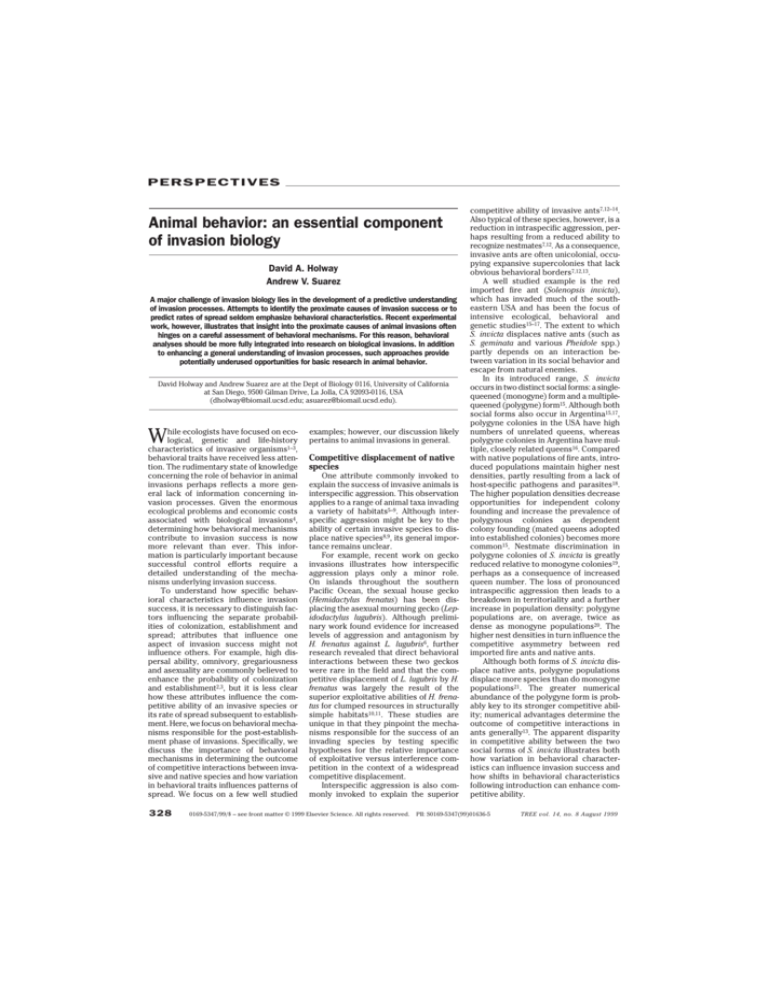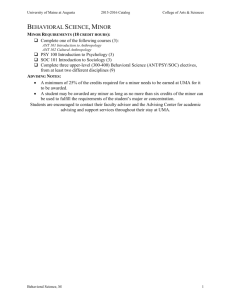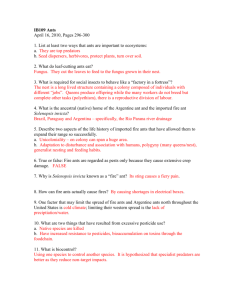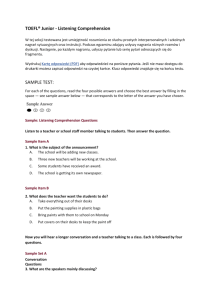
PERSPECTIVES
Animal behavior: an essential component
of invasion biology
David A. Holway
Andrew V. Suarez
A major challenge of invasion biology lies in the development of a predictive understanding
of invasion processes. Attempts to identify the proximate causes of invasion success or to
predict rates of spread seldom emphasize behavioral characteristics. Recent experimental
work, however, illustrates that insight into the proximate causes of animal invasions often
hinges on a careful assessment of behavioral mechanisms. For this reason, behavioral
analyses should be more fully integrated into research on biological invasions. In addition
to enhancing a general understanding of invasion processes, such approaches provide
potentially underused opportunities for basic research in animal behavior.
David Holway and Andrew Suarez are at the Dept of Biology 0116, University of California
at San Diego, 9500 Gilman Drive, La Jolla, CA 92093-0116, USA
(dholway@biomail.ucsd.edu; asuarez@biomail.ucsd.edu).
W
hile ecologists have focused on ecological, genetic and life-history
characteristics of invasive organisms1–3,
behavioral traits have received less attention. The rudimentary state of knowledge
concerning the role of behavior in animal
invasions perhaps reflects a more general lack of information concerning invasion processes. Given the enormous
ecological problems and economic costs
associated with biological invasions4,
determining how behavioral mechanisms
contribute to invasion success is now
more relevant than ever. This information is particularly important because
successful control efforts require a
detailed understanding of the mechanisms underlying invasion success.
To understand how specific behavioral characteristics influence invasion
success, it is necessary to distinguish factors influencing the separate probabilities of colonization, establishment and
spread; attributes that influence one
aspect of invasion success might not
influence others. For example, high dispersal ability, omnivory, gregariousness
and asexuality are commonly believed to
enhance the probability of colonization
and establishment2,3, but it is less clear
how these attributes influence the competitive ability of an invasive species or
its rate of spread subsequent to establishment. Here, we focus on behavioral mechanisms responsible for the post-establishment phase of invasions. Specifically, we
discuss the importance of behavioral
mechanisms in determining the outcome
of competitive interactions between invasive and native species and how variation
in behavioral traits influences patterns of
spread. We focus on a few well studied
328
examples; however, our discussion likely
pertains to animal invasions in general.
Competitive displacement of native
species
One attribute commonly invoked to
explain the success of invasive animals is
interspecific aggression. This observation
applies to a range of animal taxa invading
a variety of habitats5–9. Although interspecific aggression might be key to the
ability of certain invasive species to displace native species8,9, its general importance remains unclear.
For example, recent work on gecko
invasions illustrates how interspecific
aggression plays only a minor role.
On islands throughout the southern
Pacific Ocean, the sexual house gecko
(Hemidactylus frenatus) has been displacing the asexual mourning gecko (Lepidodactylus lugubris). Although preliminary work found evidence for increased
levels of aggression and antagonism by
H. frenatus against L. lugubris6, further
research revealed that direct behavioral
interactions between these two geckos
were rare in the field and that the competitive displacement of L. lugubris by H.
frenatus was largely the result of the
superior exploitative abilities of H. frenatus for clumped resources in structurally
simple habitats10,11. These studies are
unique in that they pinpoint the mechanisms responsible for the success of an
invading species by testing specific
hypotheses for the relative importance
of exploitative versus interference competition in the context of a widespread
competitive displacement.
Interspecific aggression is also commonly invoked to explain the superior
0169-5347/99/$ – see front matter © 1999 Elsevier Science. All rights reserved.
competitive ability of invasive ants7,12–14.
Also typical of these species, however, is a
reduction in intraspecific aggression, perhaps resulting from a reduced ability to
recognize nestmates7,12. As a consequence,
invasive ants are often unicolonial, occupying expansive supercolonies that lack
obvious behavioral borders7,12,13.
A well studied example is the red
imported fire ant (Solenopsis invicta),
which has invaded much of the southeastern USA and has been the focus of
intensive ecological, behavioral and
genetic studies15–17. The extent to which
S. invicta displaces native ants (such as
S. geminata and various Pheidole spp.)
partly depends on an interaction between variation in its social behavior and
escape from natural enemies.
In its introduced range, S. invicta
occurs in two distinct social forms: a singlequeened (monogyne) form and a multiplequeened (polygyne) form15. Although both
social forms also occur in Argentina15,17,
polygyne colonies in the USA have high
numbers of unrelated queens, whereas
polygyne colonies in Argentina have multiple, closely related queens16. Compared
with native populations of fire ants, introduced populations maintain higher nest
densities, partly resulting from a lack of
host-specific pathogens and parasites18.
The higher population densities decrease
opportunities for independent colony
founding and increase the prevalence of
polygynous colonies as dependent
colony founding (mated queens adopted
into established colonies) becomes more
common15. Nestmate discrimination in
polygyne colonies of S. invicta is greatly
reduced relative to monogyne colonies19,
perhaps as a consequence of increased
queen number. The loss of pronounced
intraspecific aggression then leads to a
breakdown in territoriality and a further
increase in population density: polygyne
populations are, on average, twice as
dense as monogyne populations20. The
higher nest densities in turn influence the
competitive asymmetry between red
imported fire ants and native ants.
Although both forms of S. invicta displace native ants, polygyne populations
displace more species than do monogyne
populations21. The greater numerical
abundance of the polygyne form is probably key to its stronger competitive ability; numerical advantages determine the
outcome of competitive interactions in
ants generally13. The apparent disparity
in competitive ability between the two
social forms of S. invicta illustrates both
how variation in behavioral characteristics can influence invasion success and
how shifts in behavioral characteristics
following introduction can enhance competitive ability.
PII: S0169-5347(99)01636-5
TREE vol. 14, no. 8 August 1999
PERSPECTIVES
The Argentine ant (Linepithema humile)
provides another example of a species
that, following introduction, has undergone behavioral changes that have increased its competitive ability. For example, recent work in South America
demonstrates that the extreme unicoloniality typical of introduced L. humile
populations is not representative of
native populations. In its native northern
Argentina, L. humile commonly exhibits
pronounced intraspecific aggression
over small spatial scales (,100 m)22.
In contrast, introduced populations
in California and Chile rarely exhibit
intraspecific aggression at any spatial
scale22,23. This widespread loss of intraspecific aggression and the concomitant
breakdown of territoriality appear to be
important contributing factors to the
high population densities typical of introduced populations12,22–24, although escape
from coevolved natural enemies25 could
also play a role. The Argentine ant’s high
population densities are central to its ability to excel at both interference and exploitative competition26,27. For example,
individual Argentine ant workers are
often unable to win fights against individual native ant workers, and must therefore rely on numerical advantages to prevail in direct confrontations with other
species26. High population densities also
contribute to its strong exploitative ability: Argentine ants discover and recruit
to food more quickly24,26,27, and in higher
numbers27,28, than many native ants.
The success of highly invasive ants,
such as L. humile and the polygyne form
of S. invicta, thus appears to be influenced to a large extent by the populationlevel consequences of reduced intraspecific aggression. Although detailed studies
of other highly invasive ant species, such
as the little fire ant (Wasmannia
auropunctata) and the big-headed ant
(Pheidole megacephala), have yet to be
done, most species of ants that invade natural communities and displace native ants
are highly unicolonial7. This pattern points
to the general importance of unicoloniality
as a determinant of competitive dominance
in ants. Given that aspects of colony structure of both the red imported fire ant and
the Argentine ant differ between the introduced and native ranges, it will be enlightening to determine if shifts in colony structure or social behavior subsequent to
introduction are general features of other
invasive ants. If so, it will be of great
interest to determine whether the routes
to unicoloniality differ among species.
Although invasive species commonly
exhibit pronounced interspecific aggression, the studies mentioned in the previous
paragraphs suggest that other behavioral
factors are also commonly involved. In
TREE vol. 14, no. 8 August 1999
some cases, differential interspecific
aggression is only one of several factors
responsible for invasion success5, or is of
minor importance10,29. It is therefore crucial to test alternative hypotheses for how
invasive species outcompete native
species8,10. Nonetheless, the question
remains as to why some invasive species
appear more aggressive than the species
they displace. Perhaps they come from
environments in which heightened aggression is adaptive30,31. For example, the infamous aggression of the africanized honeybee (Apis mellifera scutellata) is thought
to be a response to a more sophisticated
suite of nest predators in Africa compared
with those present in the native ranges of
the more docile races of this species5.
The studies also suggest that the ecological success of invasive species might
result from behavioral changes that occur
subsequent to introduction, raising the
question of why behavioral shifts occur
in species invading new environments.
One answer is that a loss of genetic variation, resulting from a bottleneck after
introduction, influences behavioral characteristics. Shifts in behavior could also be
adaptive responses to new environments.
Such introductions can be used to test the
selective forces responsible for maintaining behavioral characteristics.
For example, Zuk et al.32 took advantage of unplanned introductions of crickets and phonotactic dipteran parasitoids
on islands in the Pacific Ocean to test
whether crickets modify their calling
behavior relative to the threat of parasitism. Compared with cricket populations lacking parasitoids, male crickets
in Hawaii sang less often when parasitoids
were active, and delivered songs composed of individual components that
were shorter in duration, suggesting that
risky behaviors were selected against in
the presence of the parasitoids32.
Similarly, the invasion of the brownheaded cowbird (Molothrus ater), an
obligate brood parasite, along the west
coast of North America33 provides an
opportunity to study the mechanisms
involved in the exploitation of novel hosts
that have not developed discriminatory
or rejection behaviors resulting from an
evolutionary history to brood parasites.
These two examples, although not
pertaining to the competitive displacement
of native species, illustrate how invasions
can be used to address fundamental
questions in animal behavior.
The role of behavior in determining
patterns of spread
An important facet of invasion biology
lies in the prediction of post-establishment
patterns of spread. This body of research has an especially rich theoretical
foundation and has generated successful
predictions of rates of spread34–36, particularly for patterns of spread that resemble
diffusion processes. Variation in behavioral characteristics, however, can influence the extent to which patterns of invasion resemble diffusion; such variation
can make predicting rates of spread a more
challenging task. For example, instances of
jump dispersal (either natural or humanmediated) violate assumptions of diffusion
models and, if common, make predictions
of invasion rate difficult to obtain36.
Invasive ants provide insightful examples of how variation in behavioral traits
can influence patterns of spatial spread. As
discussed already, the monogyne and
polygyne forms of the red imported fire ant
differ in numerous respects, including
modes of dispersal and colony reproduction. Queens from monogyne colonies take
part in mating flights and found colonies
independently, whereas queens from
polygyne colonies are adopted into established nests after mating and, as a consequence, colony reproduction occurs by
budding15. These contrasting modes of
dispersal result in a complex pattern of
invasion, with the monogyne populations
spreading three orders of magnitude more
quickly than polygyne populations37.
Superimposed onto these dual modes of
spread is human-mediated dispersal,
which can introduce propagules (e.g. small
colonies and inseminated queens) well
ahead of main invasion fronts. The recent
and unfortunate human-assisted arrival
of the red imported fire ant into southern
California, USA, could offer a unique
opportunity to scrutinize the interplay
between these different modes of dispersal
in a new environment.
The Argentine ant provides an even
more extreme example. This species, at
least in its introduced range, appears to
undergo colony reproduction solely by
budding. However, the Argentine ant’s
opportunistic nesting behavior and general dietary requirements allow this
species to commonly associate with
humans, greatly increasing the frequency
of accidental transport. Because the maximum rates of spread for budding reproduction in this species are a few hundred
meters a year, large-scale patterns of
spread in this invasion are dictated by
human-mediated jump dispersal38.
These examples illustrate that variation in behavioral characteristics can
influence spatial patterns of invasion and
that the resulting patterns can deviate
from simple diffusion (see Refs 39,40 for
additional examples). Such complex
patterns of spread are probably common
and present an important challenge
to the theory on the spatial spread of
invasions35,36.
329
PERSPECTIVES
Conclusions
There has been a recent growth of
interest in the importance of behavioral
mechanisms to aspects of conservation
biology41–43. Given the grave problems
caused by biological invasions, an improved understanding of how behavior
contributes to the competitive ability
and spread of invasive animals is also
needed. This information will not only
aid control efforts for particular species,
but the identification of behavioral attributes common to different invasive taxa
could also provide a basis for predicting
which species have the potential to
become problematic invaders.
The behavior of invasive species might
also be relevant to basic research in animal behavior. Although a compelling
case has been made for using introduced
species to study social evolution15, behavioral comparisons between native
and introduced populations can be used
more generally to examine the plasticity
of behavioral repertoires or to test the
specific forces responsible for the maintenance of behavioral characteristics. In
this light, invasions might contribute to
the study of animal behavior in ways that
are reminiscent of how they have been
used in community ecology to study
interspecific competition10,30, apparent
competition44 and trophic relationships3.
Acknowledgements
We thank T.J. Case, L. Keller, T. Langen,
K. Marchetti, K. Petren, J.E. Ragsdale,
N.D. Tsutsui and an anonymous reviewer
for comments and valuable discussion.
This work was supported by a USDA
Postdoctoral Fellowship 97-35302-4920
(D.H.), an NIH CMG training grant
GMO 7240 (A.S.) and the Canon National
Parks Science Scholars Program (A.S.).
References
1 Lawton, J.H. and Brown, K.C. (1986) The
population and community ecology of
invading insects, Philos. Trans. R. Soc. London
Ser. B 314, 607–617
2 Ehrlich, P.R. (1989) Attributes of invaders and
the invading processes: vertebrates, in
Biological Invasions: A Global Perspective
(Drake, J.A. et al., eds), pp. 315–328, Wiley
3 Lodge, D.M. (1993) Biological invasions: lessons
for ecology, Trends Ecol. Evol. 8, 133–137
4 Vitousek, P.M. et al. (1996) Biological
invasions as global environmental change,
Am. Sci. 84, 468–477
5 Winston, M.L. (1992) The biology and
management of africanized honey bees,
Annu. Rev. Entomol. 37, 173–193
6 Bolger, D.T. and Case, T.J. (1992) Intra- and
interspecific interference behavior among
sexual and asexual geckos, Anim. Behav. 44,
21–30
7 Passera, L. (1994) Characteristics of tramp
species, in Exotic Ants: Biology, Impact, and
Control of Introduced Species (Williams, D.F.,
ed.), pp. 23–43, Westview Press
330
8 Dick, J.T.A., Elwood, R.W. and Montgomery, W.I.
(1995) The behavioural basis of a species
replacement: differential aggression and
predation between the introduced
Gammarus pulex and the native G. duebeni
celticus (Amphipoda), Behav. Ecol. Sociobiol.
37, 393–398
9 Gamradt, S.C., Katz, L.B. and Anzalone, C.B.
(1997) Aggression by non-native crayfish
deters breeding in California newts, Conserv.
Biol. 11, 793–796
10 Petren, K. and Case, T.J. (1996) An
experimental demonstration of exploitation
competition in an ongoing invasion, Ecology
77, 118–132
11 Petren, K. and Case, T.J. (1999) Coexistence of
invasive gecko lizards is determined by
habitat structure, Proc. Natl. Acad. Sci. U. S. A.
95, 11739–11744
12 Hölldobler, B. and Wilson, E.O. (1977) The
number of queens: an important trait in ant
evolution, Naturwissenschaften 64, 8–15
13 Holldobler, B. and Wilson, E.O. (1990) The
Ants, Harvard University Press
14 Human, K.G. and Gordon, D.M. (1999)
Behavioral interactions of the invasive
Argentine ant with native ant species, Insect.
Soc. 46, 159–163
15 Ross, K.G and Keller, L. (1995) Ecology and
evolution of social organization: insights
from fire ants and other highly eusocial
insects, Annu. Rev. Ecol. Syst. 26, 631–656
16 Ross, K.G., Vargo, E.L. and Keller, L. (1996)
Social evolution in a new environment: the
case of introduced fire ants, Proc. Natl. Acad.
Sci. U. S. A. 93, 3021–3025
17 Tschinkel, W.R. (1998) The reproductive biology
of fire ant societies, Bioscience 48, 593–605
18 Porter, S.D. et al. (1997) Intercontinental
differences in the abundance of Solenopsis
fire ants (Hymenoptera: Formicidae): escape
from natural enemies? Environ. Entomol. 26,
373–384
19 Vandermeer, R.K., Obin, M.S. and Morel, L.
(1991) Nestmate recognition in fire ants:
monogyne and polygyne populations, in
Applied Myrmecology: A World Perspective
(Vandermeer, R.K., Jaffe, K. and Cedeno, A.,
eds), pp. 322–328, Westview Press
20 Macom, T.E. and Porter, S.D. (1996)
Comparison of polygyne and monogyne
imported red fire ant (Hymenoptera:
Formicidae) population densities, Ann.
Entomol. Soc. Am. 89, 535–543
21 Porter, S.D. and Savignano, D.A. (1990)
Invasion of polygyne fire ants decimates
native ants and disrupts arthropod
community, Ecology 71, 2095–2106
22 Suarez, A.V. et al. Behavioral and genetic
differentiation between native and
introduced populations of the Argentine ant,
Biol. Invasions (in press)
23 Holway, D.A., Suarez, A.V. and Case, T.J. (1998)
Loss of intraspecific aggression underlies the
success of a widespread invasive social
insect, Science 287, 949–952
24 Holway, D.A. (1998) Effect of Argentine ant
invasions on ground-dwelling arthropods in
northern California riparian woodlands,
Oecologia 116, 252–258
25 Orr, M.R. and Seike, S.H. (1998) Parasitoids
deter foraging by Argentine ants
(Linepithema humile) in their native habitat
in Brazil, Oecologia 117, 420–425
26 Holway, D.A. (1999) Competitive mechanisms
underlying the displacement of native ants
by the invasive Argentine ant, Ecology 80,
238–251
27 Human, K.G. and Gordon, D.M. (1996)
Exploitation and interference competition
between the invasive Argentine ant,
Linepithema humile, and native ant species,
Oecologia 105, 405–412
28 Holway, D.A. (1998) Factors governing rate
of invasion: a natural experiment using
Argentine ants, Oecologia 115, 206–212
29 Probert, B.L. and Litvaitis, J.A. (1996)
Behavioral interactions between invading
and endemic lagomorphs: implications for
conserving a declining species, Biol. Conserv.
76, 289–295
30 Diamond, J. and Case, T.J. (1986) Overview:
introductions, extinctions, exterminations,
and invasions, in Community Ecology
(Diamond, J. and Case, T.J., eds), pp. 65–79,
Harper and Row
31 Vermeij, G. (1991) When biotas meet:
understanding biotic interchange, Science
253, 1099–1104
32 Zuk, M., Simmons, L.W. and Cupp, L. (1993)
Calling characteristics of parasitized
populations of the field cricket Teleogryllus
oceanicus, Behav. Ecol. Sociobiol. 33,
339–343
33 Rothstein, S.I. (1994) The cowbird’s invasion
of the far west: history, causes, and
consequences experienced by host species,
Stud. Avian Biol. 15, 301–315
34 Andow, D.A. et al. (1990) The spread of
invading organisms, Landscape Ecol. 4,
177–188
35 Hastings, A. (1996) Models of spatial spread:
is the theory complete? Ecology 77, 1675–1679
36 Lewis, M.A. (1998) Variability, patchiness and
jump dispersal in the spread of an invading
population, in Spatial Ecology: The Role of
Space in Population Dynamics and Interspecific
Interactions (Tilman, D. and Kareiva, P., eds),
pp. 46–69, Princeton University Press
37 Porter, S.D., Van Eimeren, B. and Gilbert, L.E.
(1988) Invasion of red imported fire ants
(Hymenoptera: Formicidae): microgeography
of competitive displacement, Ann. Entomol.
Soc. Am. 81, 913–918
38 Holway, D.A. (1995) The distribution of the
Argentine ant in northern California, Conserv.
Biol. 9, 1634–1637
39 Carey, J.R. (1997) The incipient
Mediterranean fruit fly invasion in
California: implications for invasion biology,
Ecology 77,1690–1697
40 Johnson, L.E. and Carlton, J.T. (1996)
Post-establishment spread in large-scale
invasions: dispersal mechanisms of the zebra
mussel (Dreissena polymorpha), Ecology 77,
1686–1687
41 Clemmons, J.R. and Buchholz, R., eds (1997)
Behavioral Approaches to Conservation in the
Wild, Cambridge University Press
42 Sutherland, W.J. (1998) The importance of
behavioral studies in conservation biology,
Anim. Behav. 56, 801–809
43 Caro, T., ed. (1998) Behavioral Ecology and
Conservation Biology, Oxford University Press
44 Holt, R.D. and Lawton, J.H. (1994) The
ecological consequences of shared
natural enemies, Annu. Rev. Ecol. Syst. 25,
495–520
TREE vol. 14, no. 8 August 1999







